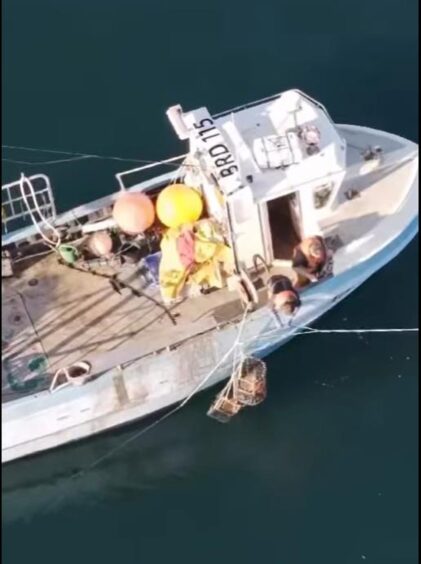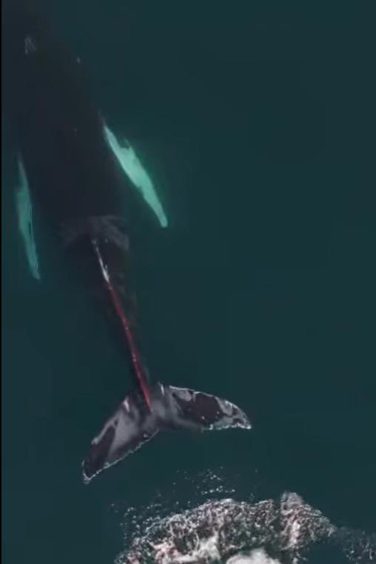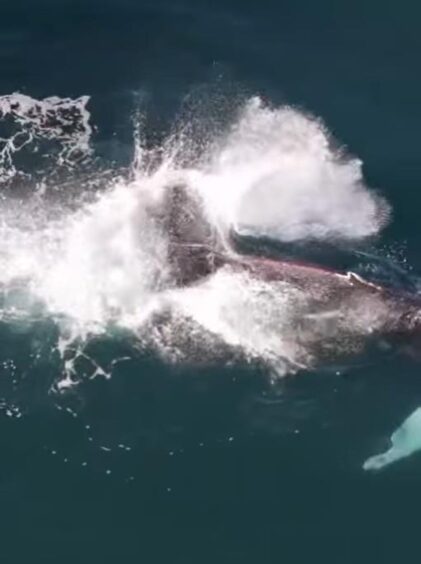Dramatic aerial footage has captured the moments in which a stricken whale was saved off the coast of Skye.
The young humpback was swimming to the north-east of the island on Sunday morning when it became entangled in creel fishing gear.
Having viewed video footage, staff from British Divers Marine Life Rescue (BDMLR) prepared to make the six-hour journey west to its aid as they believed the whale had become entangled in the end line.
But nearby creel fishermen Bally Philip and Haydn Mackenzie had by then received a video showing a much more concerning tale playing out.
The clip showed the whale stranded in about 35 metres of water, struggling to reach the surface after becoming entangled within the creel gear.
Concerned for its safety, skipper Bally felt the rescue was “time crucial” and made haste to the whale’s location.
Race against time to save humpback whale
Bally and Haydn – who were trained by the Scottish Entanglement Alliance (SEA, based at the University of Glasgow) – took about an hour to reach the scene.
They met with volunteers and wasted no time in setting about freeing the whale.
Using the winch onboard their vessel, the fishermen carefully peeled back the gear to relieve the weight from the whale’s tail.
Speaking to The Press and Journal, Bally detailed the events of the rescue operation, stressing time was of the essence.
“When we arrived on the scene, we had a quick meeting and we all agreed that the whale was in more danger than the original assessment and we should act aright away,” he said.
“We resolved to pick up the creel ends – there is a buoy at the end of the creels – and the original idea wasn’t necessarily to disentangle the whale straight away but was to lift the weight off the whale to make sure it was able to reach the surface easily.
“We hauled the gear very, very slowly, keeping an eye on how the whale was getting on the whole time. You don’t want it to panic.
One simple cut and the net came away
“It became obvious the whale was getting lighter as it were – we were relieving the weight that it was previously holding itself.
“We kept hauling the gear and eventually we could see the whale was close by and it was a very easy thing to untangle.
“We just needed one simple cut with a knife, so we disentangled it there and then.”
Bally added: “It didn’t make any sense to wait for the official disentanglement team.
“We were in very calm weather conditions.
“The water was crystal clear and you could see how the whale was behaving, so it was about as easy and good as a disentanglement could possibly get.”
The skipper said the juvenile whale thrashed its tail before swimming away with ease – a euphoric sight for all involved.
Bally added: “You can’t get a better feeling than knowing you have helped save the life of such a precious creature.
“It was very uplifting, especially because until it does swim away free, you are thinking to yourself “My goodness, this creature could drown”.
“When it swims away free, then you know it has been a successful mission.”
Training fishermen in disentanglement techniques
Bally, who has been a skipper for more than three decades, says operations of this nature require specialised training.
“That is something he hopes more fishermen will have access to in the future.
He said: “I don’t think people who don’t have any training should really be attempting to disentangle whales because they are potentially very dangerous.
“And it’s easy to make a mistake.
“You have to ensure every piece of rope is off the animal.
“If the animal swims away free and still has a little bit of rope wrapped around it, that bit of rope could constrict and amputate a limb or kill the animal.
“It’s really fundamentally important that you have a cutting plan.
“For us, it was quite simple because there was only one cut required but for slightly more complex entanglements, you have to decide what order you are going to cut things in.”
Through his work with the Scottish Creel Fisherman’s Federation, Bally is collaborating with the Scottish Entanglement Alliance to provide trials on negatively buoyant rope while gathering funding to host another disentanglement course.
The Highland skipper says the training course is important to “make sure there are more people able to respond to another incident like this”.



Conversation